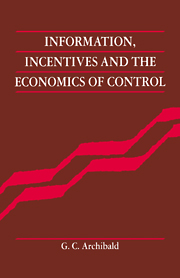Book contents
- Frontmatter
- Contents
- Preface
- Part I Introductory
- Part II Iterative controls
- 3 Feed-back control processes
- 4 First example: an externality problem
- 5 Second application of the control process: Lerner's Problem
- 6 Third example of the control process: implementation of a second-best solution
- 7 Two examples of the control process in a mixed economy
- Part III Non-convexities
- Part IV Cooperatives
- Appendix: The taxation of economic rent
- Notes
- Bibliography
- Index
6 - Third example of the control process: implementation of a second-best solution
Published online by Cambridge University Press: 19 October 2009
- Frontmatter
- Contents
- Preface
- Part I Introductory
- Part II Iterative controls
- 3 Feed-back control processes
- 4 First example: an externality problem
- 5 Second application of the control process: Lerner's Problem
- 6 Third example of the control process: implementation of a second-best solution
- 7 Two examples of the control process in a mixed economy
- Part III Non-convexities
- Part IV Cooperatives
- Appendix: The taxation of economic rent
- Notes
- Bibliography
- Index
Summary
A Second-Best problem
The object of ch. 6 is not, I fear, to offer any serious solution to the general problem of the Second Best. It has three much less ambitious objects. The first is to suggest a new use for a familiar Criterion Function, the simple “cost-benefit” criterion of the project-evaluation literature (see Hammond, 1980). The second is to clear up operationally the old question of which definition of complementarity is appropriate in dealing with Second-Best solutions (on which see Corlett and Hague, 1954; Meade, 1955a and 1955b; and of course Lipsey and Lancaster, 1957). The third is to illustrate the use of adaptive control methods in a general rather than, as hitherto, a purely partial-equilibrium model.
We have had occasion to notice, in ch. 5, two familiar reasons for thinking that the standard First-Best solution is unattainable and/or undesirable: aversion to risk and preference for leisure. In the explicit Second-Best literature neither of these difficulties has been addressed: it has rather been assumed that the reason for First Best being unattainable is lack of instruments: that the government will not alter a tax or tariff, or cannot control an important monopolist. Here I shall follow the Second-Best literature: for illustrative purposes, I shall ignore both risk and effort. First Best will be unattainable due only to lack of instruments with which to control a monopolist; and, though a certain non-convexity in the technology will be assumed, it will be only to facilitate exposition.
- Type
- Chapter
- Information
- Information, Incentives and the Economics of Control , pp. 70 - 78Publisher: Cambridge University PressPrint publication year: 1992



